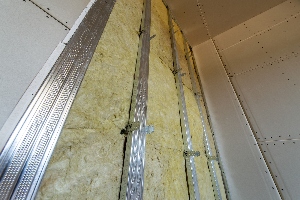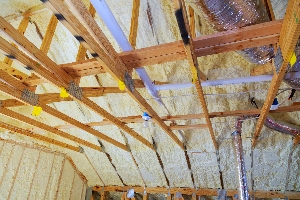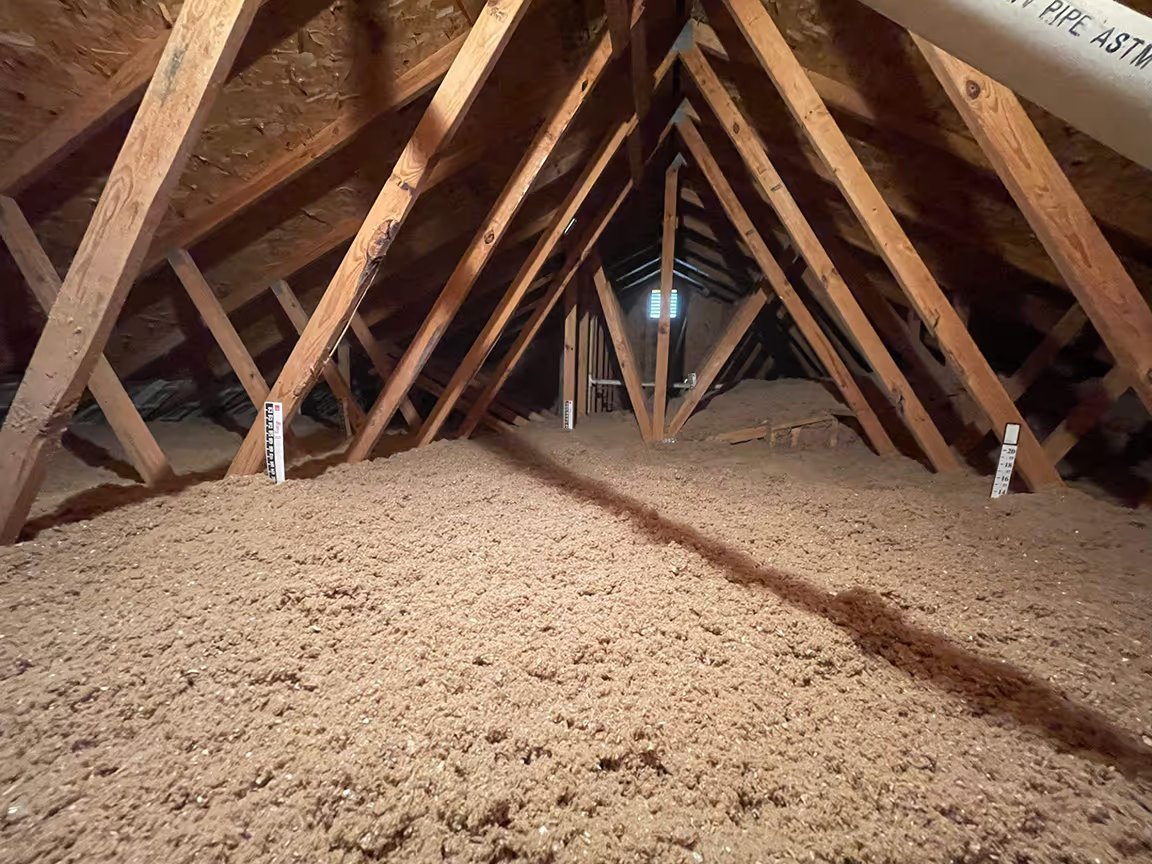How to tell if your attic needs more insulation is a common concern for homeowners struggling with high energy bills or inconsistent room temperatures.
According to the Insulation Institute, about 90% of US homes are under-insulated, leading to wasted energy and uncomfortable living conditions. You likely need more attic insulation if you can easily see your floor joists or if the insulation is level with or below them.
We can help you determine if your attic needs attention. A simple visual check of your attic floor provides valuable clues - if insulation doesn't rise above the joists, it's time to add more. This quick assessment can save you money on energy bills and prevent problems like ice dams during winter months.
Proper insulation creates a comfortable home temperature year-round while reducing energy costs.
If you're experiencing uneven temperatures throughout your house or noticing higher utility bills, these are additional signs that your attic insulation may be insufficient. Water damage and pest infestations can also compromise insulation effectiveness, requiring replacement rather than just adding more.
This article explains how to spot the signs of poor attic insulation and what steps you can take to improve comfort and energy efficiency, starting with a simple attic inspection.
Here's what you need to know:
- Signs your attic may not have enough insulation
- Why poor attic insulation affects the whole house
- How to inspect your attic insulation
- When to call a professional for deeper analysis
- What to do if your attic needs more insulation
Good reading!
Signs your attic may not have enough insulation
Your attic insulation plays a crucial role in maintaining home comfort and energy efficiency. Poor insulation can lead to significant problems that affect both your comfort and wallet.
Rising energy bills, even in mild weather
When your attic lacks proper insulation, your heating and cooling systems must work harder to maintain comfortable temperatures. This extra effort directly impacts your energy bills, causing them to rise even during mild weather.
Many homeowners notice a gradual increase in monthly utility costs without any change in usage patterns. This is often one of the first indicators of insufficient attic insulation.
In well-insulated homes, energy bills typically remain stable with seasonal changes. When insulation is inadequate, you'll see costs spike during extreme temperatures as your HVAC system struggles to compensate.
Track your energy bills over several months. If you notice unexplained increases of 10% or more, your attic insulation may be the culprit.
Rooms below the attic feel hot or cold
The rooms directly beneath your attic serve as excellent indicators of insulation problems. These spaces are most affected by poor thermal barriers above.
In summer, insufficiently insulated attics allow heat to radiate downward, making upstairs rooms uncomfortably warm. During winter, heat escapes upward through the same inadequate insulation, leaving these rooms noticeably colder than the rest of your home.
This temperature inconsistency creates an unstable thermal envelope throughout your house. You might find yourself constantly adjusting thermostats or using space heaters and fans to compensate.
Touch the ceiling in these rooms. If it feels warmer or cooler than the ambient room temperature (depending on the season), this suggests heat transfer problems due to poor attic insulation.
Icicles in winter or fast snow melt on roof
In cold climates, your roof can reveal telling signs of insulation problems. Excessive icicle formation along your roofline or gutters isn't just a winter wonderland effect, it's a warning sign.
This happens when heat escapes through your attic, warming the roof surface. Snow melts, runs down to the colder roof edge, and refreezes as icicles or ice dams. These ice formations can damage your roof and gutters over time.
Another indicator is uneven snow melt patterns on your roof. If snow melts quickly in certain areas while remaining intact in others, you likely have insulation gaps or thin spots.
These winter warning signs are particularly important to address, as they can lead to water damage when ice dams force melted snow under shingles.
You can see joists or uneven insulation levels
A visual inspection of your attic can provide immediate evidence of insulation problems. If you can see floor joists above your insulation, it's too thin by modern standards.
Current recommendations for attic insulation depth vary by climate zone, but generally range from 13 to 18 inches. When joists (typically 8-10 inches high) remain visible, your insulation falls short of recommended levels.
Uneven insulation distribution is another red flag. Properly installed insulation should form a consistent layer across the entire attic floor. Gaps, compressed areas, or varying depths compromise your thermal barrier.
Look for signs of discoloration or moisture damage in existing insulation. Dark spots, mold, or compressed areas indicate the insulation has been compromised and is no longer performing effectively.
Why poor attic insulation affects the whole house
Your attic's insulation is a critical part of your home's building envelope. When it fails to do its job, the effects spread throughout your entire house, impacting comfort, energy bills, and even structural integrity.
Heat loss and heat gain through the roof
Poor attic insulation allows up to 25% of your home's heat to escape through the roof in winter. This happens because heat naturally rises and will find any path to the outdoors.
In summer, the problem reverses. Inadequate insulation lets hot air from your sun-baked roof penetrate downward into your living spaces. This creates a double burden on your cooling system.
The R-value of your insulation determines how effectively it blocks this unwanted heat transfer. Higher R-values mean better insulation performance. Many homes have outdated insulation with R-values far below current recommendations.
We often see homes with patchy or compressed insulation that creates "thermal bridges" - areas where heat moves freely between indoor and outdoor environments.
Overworking your hvac and reducing its lifespan
When your attic insulation fails, your HVAC system must work overtime. This constant strain leads to:
- Higher energy bills (often 10-20% higher)
- More frequent repairs as components wear out
- Shortened system lifespan (sometimes by 3-5 years)
- Inconsistent temperatures throughout your home
Your heating and cooling equipment wasn't designed to compensate for poor insulation. The continuous cycling on and off as it struggles to maintain temperature puts excessive wear on motors, compressors, and electrical systems.
We find that many homeowners replace their HVAC systems without addressing the underlying insulation problems. This means the new system immediately begins suffering the same stresses.
Moisture problems and potential mold in roof structure
Inadequate attic insulation creates conditions where warm, moist indoor air meets cold surfaces. This causes condensation on roof components.
Over time, this moisture can lead to:
- Wood rot in roof trusses and decking
- Mold growth that spreads to other areas
- Damaged or stained ceilings
- Compromised indoor air quality
Proper insulation works with ventilation to keep moisture levels in check. Without this balance, your attic becomes a breeding ground for mold and mildew.
We've seen cases where poor attic insulation led to extensive structural repairs that could have been avoided. Water damage from condensation can be as destructive as a roof leak, yet many homeowners never realize the source of the problem.
How to inspect your attic insulation
Checking your attic insulation is straightforward if you know what to look for. You'll need to examine both the depth of your insulation and identify the type of material used to determine if your attic needs more coverage.
How Many Inches of Insulation Your Attic Should Have
The recommended insulation depth varies based on your climate zone. In most regions, attic insulation should be between 10-14 inches deep (R-30 to R-49). If your insulation is level with or below the floor joists, you likely need to add more.
A simple way to check is to look across your attic floor. When joists are visible or the insulation doesn't rise above them, more insulation would be beneficial.
We recommend using a measuring tape to determine the exact depth. Place it vertically into the insulation until it touches the attic floor, then note the measurement.
Climate zones in the northern US typically require R-49 to R-60 (about 16-20 inches), while southern regions may only need R-30 to R-38 (about 10-13 inches).
What different materials look like and how to measure
Fiberglass insulation appears as pink, yellow, or white fluffy batts or loose fill. It's the most common type and typically provides R-3 to R-4 per inch of thickness.
Cellulose insulation looks like gray or brown shredded paper and provides about R-3.5 per inch. This recycled material fills gaps effectively.
Spray foam insulation is white or yellow and feels firm to the touch, offering R-6 to R-7 per inch.
To properly measure effectiveness, we suggest:
- Using a thermal imaging camera to identify cold spots
- Checking for gaps or compressed areas
- Looking for signs of moisture or pest damage
DIY inspections work well, but professional evaluations provide the most accurate assessment of your insulation's condition and performance.
When to call a professional for deeper analysis
While DIY inspection can reveal obvious insulation issues, professionals have specialized tools and expertise to identify hidden problems. They can detect air leaks, moisture issues, and insulation gaps that might not be visible to the untrained eye.
Thermal imaging assessment
Professional energy auditors use thermal imaging cameras to create detailed heat maps of your home. These cameras detect temperature differences that indicate where heat is escaping through insufficient insulation.
The process is non-invasive and reveals problems invisible to the naked eye. A thermal scan can show exactly where your attic is losing energy, even behind walls or in difficult-to-reach areas.
We recommend thermal imaging when:
- Your energy bills remain high after adding insulation
- You've addressed obvious issues but still have temperature fluctuations
- You're planning a major renovation and want to solve existing problems
Most professional energy audits include this service as part of a comprehensive assessment.
Identifying hard-to-detect issues
Professional inspectors can identify complex insulation problems that DIY checks might miss. They have the training to spot moisture issues that could lead to mold growth or structural damage.
Professionals will check for:
- Proper ventilation balance (crucial for attic performance)
- Electrical hazards from improperly installed insulation
- Signs of pest infestation that could damage insulation
- Hidden air leaks around chimneys, vents, and recessed lighting
These experts can also assess whether your current insulation meets local building codes. Many homes built before modern energy standards need significant upgrades.
We suggest calling a professional if you notice musty smells, water stains, or if your home is more than 20 years old and has never had an energy audit.
What to do if your attic needs more insulation
Once you've identified that your attic needs more insulation, it's time to take action. Proper insulation can lower your energy bills by up to 20% and make your home more comfortable year-round.
Options for adding: blown-in, batt, or spray foam
Blown-in insulation is popular for existing homes because it fills spaces completely. Made from cellulose or fiberglass, it's installed using special equipment that blows the material into place. It works well for irregularly shaped areas and around obstacles.
Batt insulation comes in pre-cut panels or rolls, typically made of fiberglass or mineral wool. It's more affordable and DIY-friendly but works best in standard-sized spaces with few obstructions. Batts need to be cut carefully around pipes and wiring to avoid gaps.
Spray foam insulation creates an air-tight seal and offers the highest R-value per inch. It comes in two types:
- Open-cell: More affordable, flexible, allows water vapor to pass
- Closed-cell: More expensive, rigid, creates a moisture barrier
Each type has its place depending on your climate, budget, and attic configuration.
Combining air sealing with insulation for best results
Air sealing should always happen before adding new insulation. Even the best insulation won't perform well if air leaks remain.
Look for gaps around:
- Chimney penetrations
- Plumbing vents
- Electrical wires
- Recessed lights
- Attic hatches
Use caulk for small gaps (less than ¼ inch) and spray foam for larger openings. For very large gaps, you might need to cut and fit rigid foam board before sealing the edges.
Air sealing typically costs $350-$600 but saves significantly on energy bills. When combined with proper insulation, air sealing can improve efficiency by 30% compared to insulation alone.
Don't forget about proper ventilation. Baffles should be installed to maintain airflow from soffit vents to ridge vents.
Rebates and tax incentives for attic insulation upgrades
Many homeowners don't realize that insulation projects often qualify for financial incentives. These can significantly reduce your overall costs.
Federal tax credits currently allow homeowners to claim up to 30% of insulation costs (materials only) through the Energy Efficient Home Improvement Credit.
Local utility companies frequently offer rebates ranging from $300-$1,500 depending on the project scope. These are typically available as:
- Direct rebates after installation
- Instant discounts through participating contractors
- Energy bill credits
State programs may provide additional incentives, especially for income-qualified households. Visit the Database of State Incentives for Renewables & Efficiency (DSIRE) website to find programs in your area.
Most incentives require professional installation and minimum R-value improvements. Keep all receipts and product documentation for tax purposes.
How Terra Insulation makes attic upgrades simple and effective
We at Terra Insulation specialize in comprehensive attic assessments and upgrades. Our process begins with a thorough inspection to identify existing insulation levels and air leakage points.
Our certified technicians use thermal imaging to find hidden problems that basic visual inspections miss. This technology shows exactly where heat is escaping through your attic.
We handle all rebate paperwork, helping you maximize available incentives. Many customers save 40-60% of project costs through these programs.
Our installation teams are trained in all insulation types, allowing us to recommend the most cost-effective solution for your specific home. We don't push premium options when mid-range products will perform adequately.
All work includes proper attic ventilation adjustments to prevent moisture problems. We also install effective attic stair insulation covers and seal all penetration points before adding new insulation material.
Conclusion
Making sure your attic has enough insulation is important for your home's comfort and energy bills. If you've noticed higher energy costs, uneven temperatures, or drafts, your attic likely needs attention.
Checking your insulation's depth is a simple first step. Remember that homes older than 10 years often need insulation updates to meet current standards.
We recommend consulting with professionals for an energy audit if you're unsure. They can provide specific recommendations for your climate zone and home design.
Adding insulation is a worthwhile investment that typically pays for itself through energy savings. Whether you choose fiberglass, cellulose, or mineral wool, proper installation is key to maximizing benefits.
Don't forget to seal air leaks before adding new insulation. This combination approach will give you the best results for your home's energy efficiency.
Regular inspections of your attic insulation every few years will help maintain your home's comfort and efficiency for decades to come.
To find out exactly how much insulation your attic needs, schedule a professional assessment with Terra Insulation.
Our team uses thermal imaging and local building standards to recommend the right solution for your home—and help you qualify for rebates.






